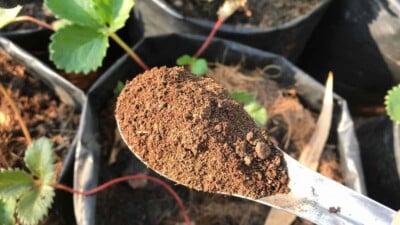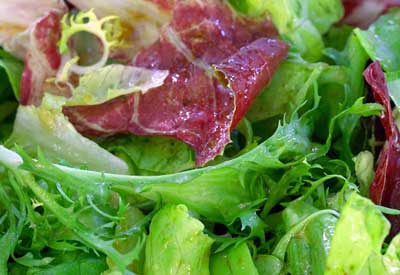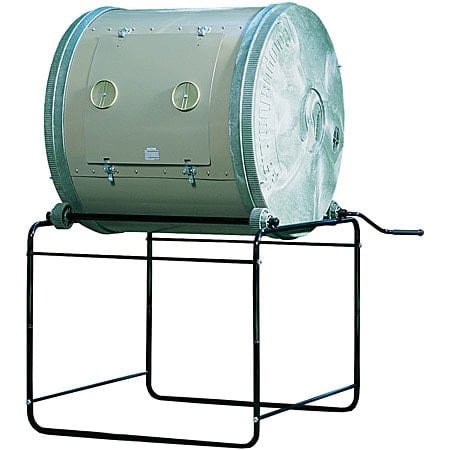How to Build a Compost Pile: Complete Guide with 9 Methods


Best Product
for Food Scraps
Kitchen Crock (White)
This ceramic container looks so good there's no need to hide it under the sink.
$29.95Learn moreThere are many effective methods of constructing a compost pile. Which is best for you? Learn all the different ways to start a compost pile in this complete guide.
Composting is something every gardener should give a shot at. Homeowners are becoming more and more aware of just how incredibly useful building a compost pile can be.
Compost is organic matter that can be added to your soil to help your plants grow bigger produce and even flowers while reducing the impact of methane gas produced by landfills simultaneously.
What Matters for a Compost Pile?
Organic composting is a natural process that breaks down a pile of yard waste and kitchen scraps.
When the right components are combined in the right amounts, bacteria, fungi, and worms create an organic substance known as in gardening circles as ‘black gold.’
The valuable organic matter is then absorbed by the soil to improve its structure, fertility, and water retention capacity.
When starting a compost pile, it’s important to keep four things in mind: carbon-to-nitrogen ratio, temperature, moisture, and aeration. We’ve discussed this in more detail in our guide on how to compost and we recommend you check it out.
One of the most common questions we get asked when it comes to composting is what you can add to your compost pile. This is where the carbon-to-nitrogen ratio comes in.
Brown materials are carbon-rich materials that give energy to the microorganisms in the pile. They also aerate the compost pile allowing for proper drainage, especially when it is set up right (more on that later!).
Browns are typically composed of wood or fibrous material and include things like dried leaves, straw, twigs, branches, stems, sawdust, cardboard, shredded newspaper, pine needles, and wood ash.
Green materials, on the other hand, are nitrogen-rich materials. They supply the proteins and amino acids necessary for the bacteria and fungi to carry out their functions in a compost pile. Plus, they are also usually wet and add moisture to your compost pile.
Some common greens include fruit and vegetable peels, leaves, grass clippings, eggshells, and even coffee grounds. You can check out the full list in our guide on composting. In general, the rule of thumb is to make sure your compost pile consists of 2/3 browns and ½ green materials.
Our composting guide also includes everything you need to avoid adding to your compost heap, including pet waste, dairy products, and animal bones. Offers large capacity, strength, versatility and beauty in your backyard.
MADE IN THE USA
Earth Engine
Different Ways to Start a Compost Pile
There are many ways you can go about building your compost pile. Let’s look at each of them in more detail:
1. Traditional: Layers Method
This by now classic method of making a compost pile offers a virtually fool-proof technique for creating fast decomposition, but remember, the idea that it must be built in layers is a myth.
The technique consists of filling a bin with layers of greens and browns, all in a single day or week, and then turning them regularly without adding any more material until the composting process has finished.
This is therefore a relatively quick method — it takes perhaps three months to get finished compost — and requires regular maintenance. It also requires that the composter have more than one heap. Otherwise, you’ve got nowhere to put the accumulating yard and kitchen waste of three months while the first pile is cooking.
If you’re just starting out and you’re looking at a mound of grass, a few orange peels and carrot ends, and a handful of leaves, this is not the right method.
The layered pile requires a big volume of material right off. For many people, autumn is the best time to build such a pile. Between fall leaves and fall garden trimming, there’s often more material available late in the year than early.
How to Build a Compost Pile using a Traditional Method
Asking how to build a compost pile is a bit like asking how to make chocolate-chip cookies. There are dozens of recipes out there, and people may have serious standoffs over whether oatmeal or walnuts can be introduced without changing the essential nature of the result.
However, certain things do seem to be agreed upon by all parties.
- Clear a spot that’s at least 3′ by 3′ and ready your bin if you’re planning to use one.
- Have on hand a large quantity of brown material (almost enough to fill the bin), about a quarter as much green material, and a bucket or two of something that contains active micro-organisms: manure (a chicken, horse, sheep, goat, or cow), finished compost, or soil.
- If you’re low on greens, they can be replaced by several cups of a high-nitrogen material like organic cottonseed meal, blood meal, or corn gluten meal.
- The browns include dead leaves, chopped stalks, wood chips, husks, nut shells, hay, and grains from the kitchen: cereals, bread, etc. Greens are grasses, fresh leaves and weeds, and vegetable and fruit kitchen scraps.
Tips for Success with the Traditional Method
- Almost everyone advises putting down a layer of coarse material — corn cobs and husks, sticks, thick fibrous stalks from vegetables, or tall flowers. This layer improves aeration at the bottom of the compost pile.
- However, if you do turn regularly, the bottom layer gets quickly incorporated into the bulk of the mix, which pretty much defeats its purpose. As this happens, the longer items in particular — the plant stems, the sticks — can make turning quite difficult. Then again, for some it’s a non-issue. You may need to try a couple of different ways for yourself to decide what works.
- Put down a thin layer of brown material — leaves, chopped stems, wood chips — and sift over it a thin layer of soil, compost, or manure. Sprinkle these with water, then start the serious layering: six to eight inches of browns, followed by two or three of greens, and then a sprinkling of the soil options.
- Water generously before starting the next layer. Keep building until the heap reaches three to four feet high and the bin is full. You can actually load material several inches above the edges of the bin; it will sink down within days.
- Check the moisture level and, ideally, cover the pile without cutting off oxygen.
2. Laissez Faire Method
The most laid-back approach to composting consists of heaving stuff onto the compost heap and walking away.
If you’re not in a hurry, this can be perfectly satisfactory. But it can be hard to keep the pile neat, and hard to access the finished compost, and such piles may be vulnerable to going anaerobic and to incursions by wildlife.
A compost bin solves the neatness problem and helps to keep the new stuff on top, separate from the finished compost at the bottom. A bin with a lid (even if it’s just loose boards) will keep out wildlife and help contain odor. Specifically designed to maximize the process with a minimal amount of effort.
FREE SHIPPING!
Tumbleweed (58 gal.)
Tips for Success with Laissez Faire Method
If your piles tend to go anaerobic, sprinkling a thin layer of finished compost or a few wood chips over them from time to time as you’re building them may be enough to solve the problem.
Dirt introduces a fetch batch of beneficial organisms to the pile, while wood chips tend to create good air pockets.
As for easy access, some compost bins are built so that you can get at the stuff at the bottom, and more than one composter has scooped compost from beneath an active heap.
Check out the bolts-and-boards bin, the swing-door bin, and the log cabin bin below. All give access to the bottom of the mix.
However, if you keep two or three compost piles going, you can turn your back forever on the unlovely task of digging finished compost out from under orange peels and eggshells. Instead, you’re adding to this year’s pile, ignoring last year’s, and using the one you built two years back. A three-compartment bin makes this remarkably neat and simple.
Detailed directions for such a bin — down to how many #9 nails you’ll need — can be found in Let It Rot.
Tyler Storey, a horticulturist and lecturer who specializes in desert gardening (he lives in Arizona), points out that the laissez-faire approach to composting doesn’t work well in the desert, where the top layers tend to dry out and the bottom ones go anaerobic.
3. Mixing it Up: Hot, Hot, Hot
If you measure out the materials for the layered method above but then stir them together before putting them in the bin, you will get an even more thorough mix than you get with the layering method.
Add a generous dose of active, mature (not old!) compost, and the result will be a pile that heats up with record speed, to record temperatures.
The easiest way to accomplish the mixing and measuring is to build the heap on a tarp, then mix the ingredients thoroughly before piling them in the bin.
This may seem redundant but, if you’re in any doubt about proportions, then building in layers is still the best way to ensure that you’ve got the appropriate brown/green ratio. Including up to ten percent wood chips will increase aeration significantly.
Since no tarp can accommodate a complete pile, make several successive “mini-batches,” as McNelly calls them, each several layers thick. Cover the mini-batch with an inch or two of finished compost, mix everything up thoroughly, and fork it into the bin, adding water as necessary. Repeat this process until the bin is full.
For maximum heat and minimum maintenance, McNally recommends building the heap on a network of sticks and stones so the ingredients will be aerated from below.
That aeration requires one last step: after building the pile, poke holes in it with a piece of rebar, working the bar in circles so that the holes don’t just collapse as soon as the rebar is withdrawn.
The method requires holes three to six inches apart across the whole top of the heap. That’s a lot of holes. However, if the compost pile has an adequate airflow, it will heat up almost overnight and stay hot for weeks without needing to be turned.
Perhaps most interesting, though McNally calls this a batch system, he also says that significant amounts of new material can be incorporated into it whenever you do decide to turn it.
4. In-Situ Garden Piles Method
Since the plan, usually, involves digging the compost into the garden, why not start there, to begin with? Why haul the stuff all the way to some specially constructed container and then haul it back?
If your first goal with a compost pile is to get rid of your kitchen scraps, such a method might not work well for you.
But if your garden is big enough to accommodate a heap, and if the bulk of your compostable material comes from the garden, these methods make a lot of sense. It all depends on how far away the garden is and what will actually work — especially in the dead of winter.
Garden heaps, which might be either hot or cold, can be located in a corner of the garden plot, or right on an unused bed. Or they can be built at one end of a row and gradually moved towards the other end as they’re turned.
This is what Barbara Pleasant and Deborah Martin, in The Complete Compost Gardening Guide, call a ‘walking pile.’
A ‘walking pile’ requires a fallow strip, of course. If you’ve got that, this is an option to be considered. It’s much easier to move a heap onto the patch of ground next to it than to turn it on itself, so the turning process is less arduous than usual.
As the season progresses, the heap moves down the bed, gradually shrinking, adding its nutrients and microbes to the soil beneath it as it moves and being enriched by the microbes in each new patch of soil.
5. Sheet Composting Method
In this method, compostable material gets spread over a garden plot or raked or dug into the top few inches of soil.
Done in the fall, most of the material will have decayed by planting time as long as it doesn’t include especially large woody items such as wood chips.
6. Drum Method
Any large barrel, garbage pail, or drum of wood, metal, or plastic that has a tight-fitting lid will work well.
Drill holes in the bottom for aeration, then fill it with the correct proportions of browns to greens, along with a bit of soil, manure, or finished compost to active micro-organisms. For added aeration, insert a perforated tube in the barrel while filling it.
Leave the barrel for several weeks, then start rotating it. The simplest way to do this is to roll it around over the yard.
A good-sized drum can hold enough material for it to truly heat up. Just fill it and roll it! The spherical shape helps mix the materials for fast results.
FREE SHIPPING!
Bio-Orb (100 gal.)
7. Trench Composting Method
Trench composting involves burying compost in a long trench right in the garden, then planting on top of it. Since composting microbes require nitrogen, which is unavailable to plants for as long as the microbes are using it, some prefer to let the trench sit for a year before planting over it.
One version of this involves a three-year rotation in which a row is divided into three strips, A, B, and C. In year one, garbage is buried in A; B is used as a path; and vegetables are planted in C. The next year, the path moves to A, vegetables are planted in B, and garbage gets buried in C. This gives the garbage two years to decay before vegetables are planted in them.
8. Underground Bins & Holes Method
In spite of the emphasis on aeration, it is indeed possible to compost underground, or at least partly so.
These methods have the distinct advantage of being virtually invisible, and for some people turning is actually easier when they’re digging compost out of a hole rather than trying to lift it over a fence.
Both of these methods start with digging a large hole — big enough to accommodate the butt end of a barrel in one case, and large enough to hold most of a compost pile in the other.
The dirt dug out of the hole can be set aside nearby and used bit by bit as an inoculator. Just sprinkle it over the mix from time to time to add great composting organisms.
If you’re setting a bin of some sort (a barrel, a drum, or a garbage can) in the hole, you have the option of angling it — which may or may not make your life easier.
Once the bin is in the hole, or once the hole is dug, you can fill it using whatever method suits you.
9. Exact Calculations Method
Most backyard gardeners don’t worry too much about the exact composition or nutrient content of their compost.
If you do really care, you can always get it analyzed, of course. But that’s expensive, and for someone trying to ensure that their compost has everything it should, it’s a bit like slamming the barn door after the horse has left.
Such a composter doesn’t want to know what’s in this batch of compost, but how to build a pile so that it will contain all the right proportions of all the right things.
Not surprisingly, the internet has what it takes to figure this out.
One of the most useful documents, “Fertilizing with Yard Trimmings (PDF),” contains a number of charts that detail the nutrient content (both total and available) of typical yard waste, as well as its moisture content, carbon/nitrogen ratio, heavy metal content (along with EPA limits), and instructions about converting all this information into application rates.
Though designed primarily for farmers and focusing on fresh rather than composted waste, this Washington State University document is invaluable for anyone who wants to know what is in the yard waste they’re composting.
Another excellent resource for those wishing to mix math with their composting is Cornell University’s site The Science and Engineering of Composting. The “Background Information” on Invertebrates, Microbes, Chemistry, and Physics can all be understood by lay people, and is of interest to anyone who wants to get an idea about what actually goes on inside a compost pile.
The next section of their site, “Getting the Right Mix,” is more technical than most people have any use for, but it offers essential information to those trying to balance their composting operations.
There are articles on how lignin and particle size affect nutrient bio-availability, others on “Moisture Content,” “Estimating Carbon Content,” “Simultaneous Solution of Moisture and C/N Equations,” and finally, downloadable spreadsheets to make it easier to record relevant measurements and work one’s way through the equations.
And there you have it, folks – those are all the top ways on how to start a compost pile easily and efficiently.


















